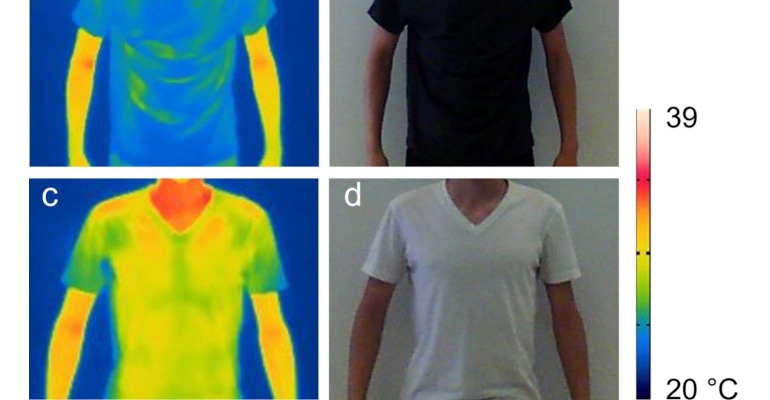MXene Coating Harnesses Infrared Radiation for Heating, Cooling
Discovery paves the way for better-performing, lighter weight, and easier-to-manufacture clothing that can help maintain body temperature in extreme conditions.
April 14, 2023

Researchers have found a new use for the carbon-based compound MXene that can potentially lead to advances in thermal clothing, heating elements, and new materials for radiative heating and cooling.
A team of scientists led by Drexel University and including researchers from the University of Pennsylvania have discovered that by applying a thin coating of the 2D nanomaterial to an object or textile, it can trap or shed heat. This result is thanks to MXene's ability to regulate the passage of ambient infrared radiation, the researchers said.
The finding shows yet another versatile use for the family of materials—discovered by scientists at Drexel in 2011—which already have proven to be useful for conducting electricity, storing electrical energy, filtering chemical compounds, and blocking electromagnetic radiation, among other potential applications.
These capabilities come with other advantages, including the thinness of MXene, which is 200 to 300 times thinner than a human hair, as well as its light weight and flexibility, noted Yury Gogotsi, distinguished university and Bach chair professor in Drexel's College of Engineering, who led the research.
The material's unique set of properties mean that it "could find applications in both localized thermal management and large-scale radiative heating and cooling systems," which would preclude the need of current solutions for electrical power to function, he said in a news statement.
Testing Various Compositions of MXene
The research team measured the ability of 10 different MXene compositions to either facilitate or limit the passage of infrared radiation to test its emissivity, a factor that also correlates with their ability to passively capture or dissipate ambient heat, they said.
The researchers already knew from previous research that MXenes can reflect or absorb radio waves and microwave radiation, explained Danzhen Zhang, a co-doctoral researcher in Gogotsi’s lab. Investigating the materials' interaction with infrared radiation, which has a much shorter wavelength, was the next logical step, he said.
“The advantage of being able to control the passage of infrared radiation is that we can use this type of radiation for passive heating—if we can contain it—or passive cooling—if we can dissipate it," Zhang explained in a press statement. "The MXenes we tested showed that they can do both, depending on their elemental composition and the number of atomic layers.”
This bodes well for the use of the coating as a passive cooling material for textiles, which potentially can perform even better than currently used materials, the researchers said. This paves the way for lightweight and high-performance clothing to help people maintain their body temperature, they said.
Current cooling textiles allow the thermal infrared radiation from the body—more commonly known as body heat—to escape through porous or lightweight composition. MXene-coated textiles, however, also can reflect external infrared radiation, to avoid heating from sunlight, while simultaneously letting body heat pass through the textile, the researchers said.
Materials and Their Performance
In terms of which type of MXenes can work best for this purpose, the researchers found that niobium carbide MXenes could effectively dissipate heat, while titanium carbide exhibited exceptional heat shielding. In fact, the latter rose in temperature only to 43 degrees Celsius after being heated for five minutes on a 110-degree hotplate, they reported
“High emissivity like in niobium carbide is also possible in dielectric materials,” Gogotsi said in a press statement. “However, MXenes combine this ability with electrical conductivity, which means these MXenes can also be used as active electrical heating elements with the supply of external power.”
The researchers also found that a coating of titanium carbide MXene could strengthen materials against infrared radiation penetration and emission, with even just a thin coating performing better as a shield against infrared radiation even better than the polished metals currently used.
Researchers published a paper on these and other findings in the Elsevier journal Materials Today.
Overall, the results of the research suggest that MXene-coated garments are effective at maintaining body temperature, while also offering not only user-friendly advantages, but also an easier manufacturing process, the researchers said. That's because they can be applied via a comparatively easier dip-coating process than most thermal clothing requires today, the researchers said.
Other uses for the MXene coating also could be to camouflage people and equipment from thermal detection devices, or to covertly transmit information via radio frequency identification codes visible only to infrared readers, the researchers said.
The researchers plan to continue studying the properties underlying MXene’s behavior to block infrared radiation as well as further test MXenes with different chemical compositions to optimize their potential as radiative heating and cooling materials, they said.
About the Author(s)
You May Also Like

.jpg?width=300&auto=webp&quality=80&disable=upscale)

